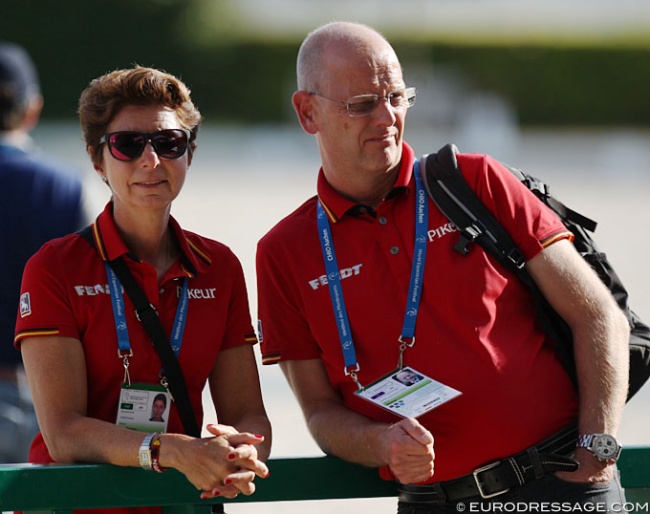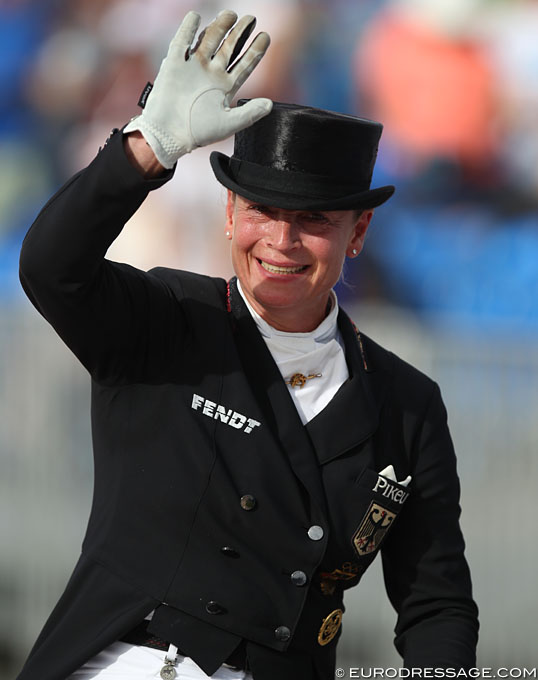
Members of the German Grand Prix squad had their annual meeting at the beginning of the year at the German Olumpic Equestrian Committee in Warendorf, where they discussed the recent developments and changes in the sport which the FEI aims to push through.
"No" seems to be the German answer to the 19 recommendations of the Dressage Judging Working Group made, and especially to the Hi/Lo drop, the Short Grand Prix and the scratching of the collectives on the score sheet.
The German squad met and discussed the 19 recommendations which the Dressage Judges Working Group made for the development and future of dressage at the 2018 FEI General Assembly in Bahrain in November.
The German Equestrian federation issued a press release with a review of the meeting and the participants' findings.
No to Hi/Lo Drop
One of the recommendations is the Hi/Lo drop, in which the highest and lowest score of all five or seven judges per movement would be dropped to come to a fairer end result. The same proposal was already made at the 2017 FEI General Assembly but then the proposal received protest. Now it's back on the table as recommendation 14, which literally reads:
14. The DJWG are of the opinion that if a score correction model is to be employed then the model based upon Hi/Lo drop per movement provides the highest level of fairness as it applies to all athletes within the same class. However, the DJWG recommends that the FEI wait until the impact of the proposed Code of Points is evaluated before assessing the need for score correction models.
"This way of judging you also have with figure skating, for instance," said the FN press releasr. "The comparison between this discipline with dressage is faulty because with figure skating the judges all sit on the same side and have the same perspective. It is part of the philosophy of dressage to assess rider and horse from a 360°-perspective. On that premise the judges sit on all sides of the arena and that is how different scores arise. Hi/Lo would limit this perspective. Only the all-round perspective ensures that the training level of a particular horse can be fully evaluated on the basis of criteria such as flexion and bending, frame lengthening, straightening, etc. Each judge has the opportunity to penalize training mistakes, such as a sunken back, a poll pulled short, an open mount or a tongue out. This also guarantees the welfare of the horse."
The squad members fear that the Hi/Lo drop would jeopardize the scores of those judges who would penalize these mistakes by letting that score become the drop score. The final result would not reflect the overall assessment. Furthermore a particularly high or low score does not automatically mean that that particular judge was wrong. Hi/Lo would encourage judges no longer to use the full spectrum of scores out of worry to become a scratch score or to get criticized by the riders, trainers or public. It will also make it harder to scout for new judges and to train the entire judges' group.
The Germans believe that Hi/Lo would stimulate mediocracy and it will become harder to distinguish the good ones from the really good ones by spectacors, judges, trainers and riders. Also the judges with the scratched scores will no longer represent the end score of their assessment.
"Transparency, fairness, traceability of an assessment, those are the goals according to the DJWG recommendations. Yet Hi/Lo will only contribute to more discussions about the judges and does not contribute to the rewarding of exceptional performances and the penalizing of training errors," said the FN press release. "The squad members agree that Hi/Lo is completely the wrong way and this conclusion was also drawn by the DOKR dressage selection committee at their December meeting."
Yes to Bringing Back the Collectives
The squad members believe that the collective marks should be re-introduced at the end of the score sheet. Three of four collectives were scratched in 2017 (Submission, Throughness, Purity of gaits, swing and elasticity), while Seat and Rider aids were kept.
The FEI Dressage Committee removed these three collectives because in principle they should already be taken into consideration by the judges in the assessment of each movement. Furthermore, it has been statistically proven that too many judges take advantage of the collectives to pull up or push down riders depending on their subjective taste. Overall results can be influenced too much, simply through the collectives and it does not allow for objective, fair judging.
The squad members preach for a return of those collectives. "The collectives are essential to value and underline the essentials of dressage training," said Monica Theodorescu.
No to the New Shortened Grand Prix

"There is nothing again the interviews after the test and individual music to make it more entertaining for the public, like they have done in Stuttgart," said Isabell Werth. "We can also see that such shows with a classic tour with Grand Prix and Special function when the conditions are right. The arena was sold out. The pseudo argument that shortened tests bring more media presence doesn't work for me and will not work unless the advocates of this belief show me a tv contract. We are faced with fundamental challenges like how to deal with sociam media and images from the warm up ring or the question whether horses should be ridden at all. In this discussion it's not about a minute less or more. We need a total package to market and develop our sport better."
The squad riders agree that the structure and length of the Grand Prix tests have a meaning and reason. The single movements build upon each other, like the two tempi changes followed by the ones. They request all what makes dressage riding and give a full image of the state of training of rider and horse. A shortening of individual movements will not lead to this goal.
"We are open to develop our sport. One can change much, but shouldn't forget that a horse stays a horse," Werth continued. "We riders often experience that a horse only starts to relax during the test as it gets used to its surroundings and it finds itself in the ring. These horses need that time. It's against the welfare of the horse to shorten the Grand Prix test. We can argue about nuances, but we can't remove flow and harmony in the test, like now. It is at the horse's expense."
The next milestone for the development of dressage will be at the 2019 FEI Sports Forum in April, followed by the 2019 FEI General Assembly in November.
Photos © Astrid Appels
Related Links
Is it Wrong to Have a Shortened Grand Prix Test?
Minderhoud and Dream Boy Win Pilot Shortened Grand Prix at 2018 CDI-W London
FEI General Assembly Approves DJWG's Proposal to Remove Collectives from Score Sheets
Biased and Nationalistic Judging Patterns Detected